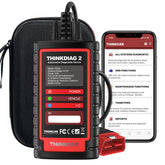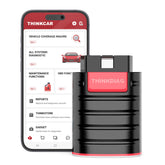What OBD Scanner Do I Need
What is OBD2?
OBD stands for On-Board Diagnostics. It’s a system that monitors the performance of your car’s engine and emissions systems, records data, and reports any problems it detects.
OBD2 is the second version of this system for cars and trucks. Starting in 1996 for gas-powered vehicles and 2008 for diesels, it is a standard system that allows you to plug a scanner into any make or model of car to access the diagnostic information stored inside. It will work for any car from a Kia Rio to a Lamborghini Murcielago.
When the computer that runs the engine detects a problem, it will record a Diagnostic Trouble Code, also known as a DTC, in its memory. If the problem is severe enough, it will turn on the check engine light on your dashboard to tell you there’s a problem. At that point, it’s time to plug in an OBD2 scanner and investigate the issue.
Back when OBD2 first came out, it was a bane to DIYers. When you got a check engine light, you were then required to take your car to the shop to find out what it meant because dealers and shops were the only ones who could read those codes with their expensive diagnostic equipment. The market saw a need, though, and soon filled it with affordable OBD2 readers for the home hobbyist. Now, anyone can read trouble codes, clear the check engine light, and continue to maintain their car themselves.
What Is an OBD2 Scanner?
The device you plug into your car’s OBD2 port to read its trouble codes and live data is generally known as a scanner. These take many forms, ranging from a tiny box barely bigger than the OBD2 port itself, to a large device connected to the port by a wire.
In locations that test your car’s emissions system, the computer that plugs into your car, communicates with the state’s auto registration database, and prints your new inspection sticker is also a type of OBD2 scanner.
How Does an OBD2 Scanner Work?
A scanner plugs into your car’s OBD2 port (typically located beneath the dash on the driver’s side) and connects to the computer that runs your engine and other systems. This computer is known as the ECU or ECM (engine control module).
With the ignition on, the car scanner can read and clear diagnostic trouble codes, reset the check engine light, monitor engine and sensor data in real time, customize features of your car, and more.
Wired (Handheld) OBD2 Scanners
A wired, or handheld, OBD2 scanner holds all of its functionality in the scanner itself, which plugs directly into the car’s OBD2 port. This is how the OBD2 system was originally designed to work with the dealer’s big expensive diagnostic systems. It still functions well, but the scanner can only do what the manufacturer designed it to do. These typically can’t be upgraded with new software to expand functionality.
The professional scanners that mechanics use typically connect to your car with a wire. The can do practically anything that OBD2 will let them. They can cost thousands of dollars, pricing it far out of range for the home hobbyist. This is why a shop may charge a $100+ diagnostic fee just to plug in their scan tool. They’re trying to make back their massive investment in this tool.
There are a few exceptions, however. Volkswagen, for example, has a system they call VAG-COM. It uses the standard OBD2 interface, but adds countless additional sensors and features to the basic OBD2 system. These are typically only accessible to dealers, but a serious Volkswagen or Audi owner can buy or build a special VAG-COM cable to connect to a Windows PC, and run a program called VCDS to gain access to all of this extra proprietary functionality. Home hobbyists can use VCDS to read proprietary trouble codes, modify door locking behavior, code a new key to work with the car, and more.
Some tuning companies, such as Cobb Tuning, supply a wired device that not only reads and clears OBD2 codes, but that also contains a variety of performance software tunes for your engine. While they work best in conjunction with an upgraded intake, exhaust, and other modifications, my Subaru WRX’s performance still improved dramatically with just the upgraded tune and original intake and exhaust. New tunes, either from Cobb Tuning or independent tuning shops, can be downloaded to the Access port from your computer, then programmed into your car.
Wireless OBD2 Scanners
Wireless scanners use Bluetooth or Wi-Fi to connect to your Android or iOS device. These let you run a multitude of apps that enable you to do far more than a basic scanner. For example, the Thinkdiag scanner and Thinkdiagapp work together to not only monitor trouble codes, but also to provide information on how to make repairs, monitor your maintenance schedule, and predict future problems with your vehicle. Other apps let you modify some of your car’s features, such as how long the interior light stays on after you close the door, or whether the horn honks when you use your remote locks.
When it comes to home use, a wireless scanner and an app on your phone are usually the best way to go, especially since you probably already have a smartphone.
How Do I Use an OBD2 Scanner?
Every 1996 or newer gas vehicle, as well as 2008 and newer diesel vehicles, has an OBD2 port located somewhere below the dashboard near the steering wheel. You can use the Thinkdiag compatibility quiz to find out if your car is compatible with an OBD2 scanner like Thinkdiag. Next, use the Thinkdiag OBD2 port finder to look up the exact location for your specific vehicle.
Plug your scanner into this port, then start your engine. A wired OBD2 scanner will turn on and begin communicating with your car automatically. For a wireless scanner, you’ll need an app for your iPhone or Android that will pair with the scanner. An app such as Thinkdiag handles this process for you with little work on your part. Other apps may require you to manually connect your phone to the scanner’s Bluetooth or Wi-Fi connection.
How to set up a Thinkdiag mini for the first time?
Step 1: Download the "ThinkDiag" in the APP store or in GooglePlay store.(ThinkDiag (IOS) / ThinkDiag+(Andriod) in App Store/Google Play.)
Step 2: Click on "Sign Up"or "Sign In" the verification code will be sent to the email you input.
Step 3: Click on "Activate" to input the serial number, and an 8-diagit activation code is on the first page of the guide.
Step 4: Plug ThinkDiag mini into the vehicle's OBDII port, there will be a red light which indicates the device is powered on.
Step 5: Open the ThinkDiag APP, it will automatically search for activated devices, select your device and connect to it via Bluetooth in the APP. The indicator will turn to flashing blue.
Step 6: In the "Diagnostics" interface of the App, download diagnostic software you need.

Conclusion
The OBD2 scanners available today are capable of far more than the limited professional use originally intended. Anyone with a smartphone can now access much of the same data as a shop with a much more affordable scanner. Tools like the Thinkdiag 2 OBD2 scanner not only read diagnostic data, but also translate the technical codes and jargon into plain English that anyone can understand, as well as display data in real time. Customization options ranging from turning on the interior lights to increasing engine horsepower are possible through what used to be just a diagnostic port. Sometimes technology really does make our lives easier.



